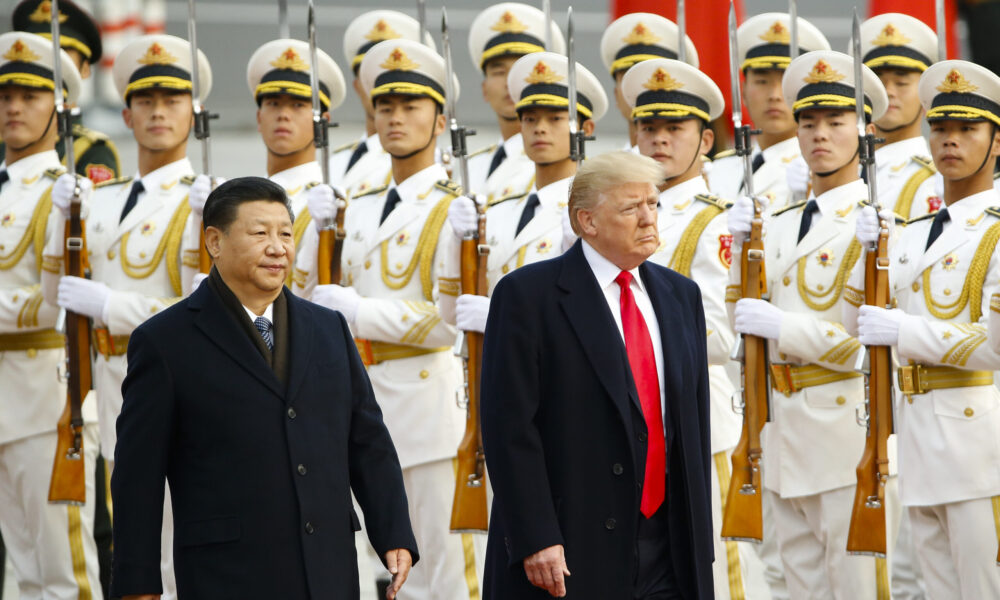At the risk of overgeneralizing, experts and officials from China and the United States do not tend to meet each other in person anymore. Two years of effectively insurmountable barriers to travel during the pandemic exacerbated pre-existing tensions, and the resulting decrease in meetings became self-reinforcing; many experts I know who visited China frequently pre-COVID have not returned since travel became possible again.
With tensions high and trust and understanding between the two nations at an all-time low, that is bad news. Both “track I” meetings (official meetings between governments) and “track II” meetings (unofficial) between Chinese and US counterparts are crucial to maintaining stable relations and communication.
Recently, I was able to visit China for the first time since COVID-19 broke out. My conversations with Chinese experts focused largely on the re-election of Donald Trump and what impact that is likely to have on US–China relations. Here are four key things they expect, worry about, or hope for under Trump 2.0.
Communication between countries has to improve
Whether progress can be made in areas like arms control depends significantly on communication between the United States and China. Channels for exchange have been decimated by COVID-19 and worsening relations. In Beijing, one expert I spoke to suggested that the worsening relationship and the reduction in opportunities for communication are mutually reinforcing; unless the trend is reversed, he worries that Washington will feel it can only communicate with Beijing militarily—through shows of force.
In the wake of President Trump’s election, many in both China and the United States were left wondering whether this would mean a harder line on China from a president remembered both for his first administration’s trade war and for his praise and apparent fondness for Chinese President Xi Jinping. So far, Trump has restarted that trade war with new 10% tariffs on Chinese products, though these are much smaller than the 60% he promised immediately after his election. At the same time, he invited President Xi to his inauguration (Chinese Vice President Han Zheng ended up attending), and his Secretary of State Marco Rubio reaffirmed the administration’s adherence to the One China Policy (the United States’ longstanding position that there is only one China, and Taiwan is part of China) in a call with his Chinese counterpart Wang Yi.
Overall, the trend for communication at the governmental level is generally encouraging. However, one related concern I heard in Beijing was that many likely appointments in the new administration might be people who “say a lot” about China without actually having much exposure to or understanding of Chinese thinking. This is rectifiable through restarting and maintaining official and unofficial dialogues. As experts I spoke to mentioned, the Chinese government is willing to negotiate, provided the United States is interested in genuine diplomacy. The attitude and approach of the last Trump administration’s negotiators were apparently quite negative, especially during arms control talks.
US–China arms control is a long shot
The prospects for progress on arms control between the United States and China are relatively thin. China is not interested in engaging with the United States on bilateral or multilateral agreements, maintaining that arms control should be conducted through international treaties like the Comprehensive Nuclear-Test-Ban Treaty (CTBT), which the United States signed in 1996 but never ratified. China also signed the treaty but did not ratify, after the United States failed to do so. While President Trump has reiterated the promise he made during his first administration to get China to negotiate a three-party arms control deal with Russia, this is unlikely to be successful unless the United States and Russia first make large reductions in their nuclear arsenals, which are several times larger than China’s.
The experts I spoke to in China reiterated many of these points, emphasizing that any progress on arms control has to start with Russia and the United States reducing their arsenals. While China has been expanding the size of its arsenal in recent years, it is still much smaller—at an estimated 600 warheads—than the 5,225 of the United States or the 5,580 of Russia. Those I spoke to did not see the Chinese expansion as indicative of a change in Beijing’s nuclear strategy. Rather, they said, it is more likely a response to concerns about growing US damage-limitation capabilities, like missile defense. Still, the Chinese expansion is a worrying part of the growing threat of nuclear weapons. Potential progress on arms control under Trump depends on whether his administration is willing to listen to China’s concerns and agree to China’s conditions for negotiating.
The risk of nuclear proliferation
Global instability is shaking the global non-proliferation regime. The failure to achieve progress on North Korean denuclearization and the recent rise in tensions across the 38th Parallel has led to increased discussion about whether South Korea should acquire nuclear weapons. At the same time, Iran and Israel have traded missiles over the last year, and there are concerns that Iran could seek to “break out” and develop a nuclear weapon. President Trump is key to both of these issues; he scuttled the Joint Comprehensive Plan of Action (or Iran nuclear deal) in 2018, and doubts about his commitment to allies like South Korea have fueled calls for Seoul to develop nuclear weapons to counter North Korea.
Experts I spoke to in China expressed concerns about Trump’s impact on non-proliferation, specifically on the Korean Peninsula. Generally, one said, the risk of proliferation in South Korea and Japan, the latter being much less likely, all comes down to Trump’s actions. Though China is opposed to the United States’ policy of extended nuclear deterrence (through which the United States promises to protect its allies and partners from attack by threatening to retaliate with nuclear weapons), the policy’s persistence will likely keep US allies from seeking nuclear weapons of their own.
Meanwhile, achieving North Korean denuclearization has become much more difficult. Another expert mentioned that he was concerned about the Trump administration either tacitly or explicitly supporting South Korea in acquiring a nuclear weapon, pointing to comments from likely administration appointees. They specifically mentioned Elbridge Colby, who has since been appointed undersecretary of defense for policy. Colby has stated that South Korea must take greater responsibility for its own defense so that the United States can put greater focus on China in a potential conflict. If South Korea did decide to acquire nuclear weapons, Colby has said, the United States should not stand in its way.
Taiwan is the most dangerous flash point
Perhaps the most important reason for stronger ties and better communication across the board is avoiding war. A conflict between the world’s two biggest economies and strongest militaries would be globally destructive. While government officials, analysts, and researchers in both countries disagree on just how likely a military conflict is, almost everyone agrees that steps must be taken to reinforce the shaky status quo; whether those steps should be military or diplomatic in nature is another point of disagreement.
Specifically, US–China tensions are a sword of Damocles hanging over the Taiwan Strait. Chinese military exercises and self-serving provocations by US politicians inch 23 million Taiwanese lives closer to the front lines of an avoidable war. Secretary Rubio’s statements were a positive first step for the new administration, but those words must be backed up by actions. In a discussion with several Chinese experts, one predicted that Rubio’s hawkish tendencies would be moderated by a Trump seeking to be more pragmatic. If not, one said, Rubio might be liable to do something like visit Taiwan himself, and if that were to happen, China would unilaterally cut diplomatic relations immediately. Another expert said they felt that Washington did not want to send messages to either Taipei or Beijing about what either side could “get away with” when it comes to the status of Taiwan. The trend in recent years, they said, is towards Washington gradually diluting its commitment to things like the Joint Communiques by which the United States agrees with China on the status of Taiwan being part of China.
On the nuclear side, Chinese experts made it clear to me that Beijing reads US publications closely, especially from think tanks it judges to have close connections to the government. When reports encourage the United States to prepare for the possible first use of nuclear weapons against a Chinese invasion of Taiwan, Beijing takes note. While Chinese leaders most likely do not believe the United States would use nuclear weapons first in that scenario, worsening relations raise the risk of misunderstandings. As another expert commented, nuclear weapons leave no room for error; we cannot afford misunderstandings and miscalculations.
Stability and predictability are what China most wants
In China, the general take on US–China relations under Trump 2.0 has been a mix of cautious optimism and pragmatism. China was caught off-guard in 2016; this time, Beijing was better prepared and ready to implement lessons from the first Trump administration in its approach to this second iteration. In interviews before the election, one Chinese expert emphasized that a Democratic administration would be preferable to a second Trump presidency. Despite some in China thinking that Trump might be more pragmatic and willing to make deals with China, they said the foundational stability of a Democratic administration would still be preferable to the significant uncertainties and instabilities likely to come with Trump.
With that in mind, reinvigorating bilateral communication, exchange, and cooperation across a variety of fields is key to securing a “floor” for US–China ties. Achieving progress on arms control, preventing more countries from acquiring nuclear weapons, and avoiding conflict in the Taiwan Strait will be hard, but all of these are made exponentially harder if the relationship remains frosty or freezes further.

